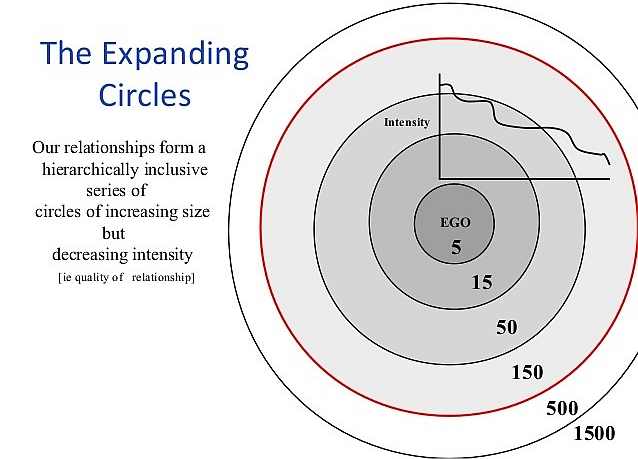
New research supports layer structure in social brain hypothesis
The social brain hypothesis1 suggests that there is a characteristic size for human social networks. This is around 150 people, and called “Dunbar’s Number” after social brain hypothesis researcher Robin Dunbar, Professor of Evolutionary Psychology at University of Oxford.
As discussed in Phys.org, the 150 relationships is made up of layers, with our closest relationship layer containing the fewest people. Dunbar and his colleagues have suggested that there are four layers, cumulatively containing 5, 15, 50 and 150 people, with the 150 being the total number of relationships. This means we have five close relationships in the first layer, and with every layer after that the number of relationships increases, but their intensity decreases, as shown in the following diagram.

In a new study2, three researchers including Robin Dunbar analyse mobile phone data to see if layers of friends can be identified from call frequencies, and how call frequency clusters compare with the layer sizes predicted by the social brain hypothesis. Different algorithms were used to break the call frequencies into clusters.
Previous studies have shown that the frequency of calls between two individuals represents relationship strength and correlates with emotional closeness. The call frequency data was filtered to eliminate casual calls and business calls, and also to remove people who weren’t using their phones as a means of regular communication with family and friends.
The results of the analysis show strong evidence for a layering structure, but finding discrete layers is a challenge. The different clustering algorithms yielded slightly different results, but all showed good support for the outer two layers, and a close match to the inner three layers for people who called between 50 and 100 other people throughout the year.
All clustering methods provided good support for two different groupings. Possible reasons for this include introverts and extroverts having a different number of layers of friends, or friendships being transient, where relationships regularly move up or down between layers. Further research is needed to investigate these possibilities.
See also: Can online social media overcome the cognitive constraint on the size of social networks?
References:
Also published on Medium.




